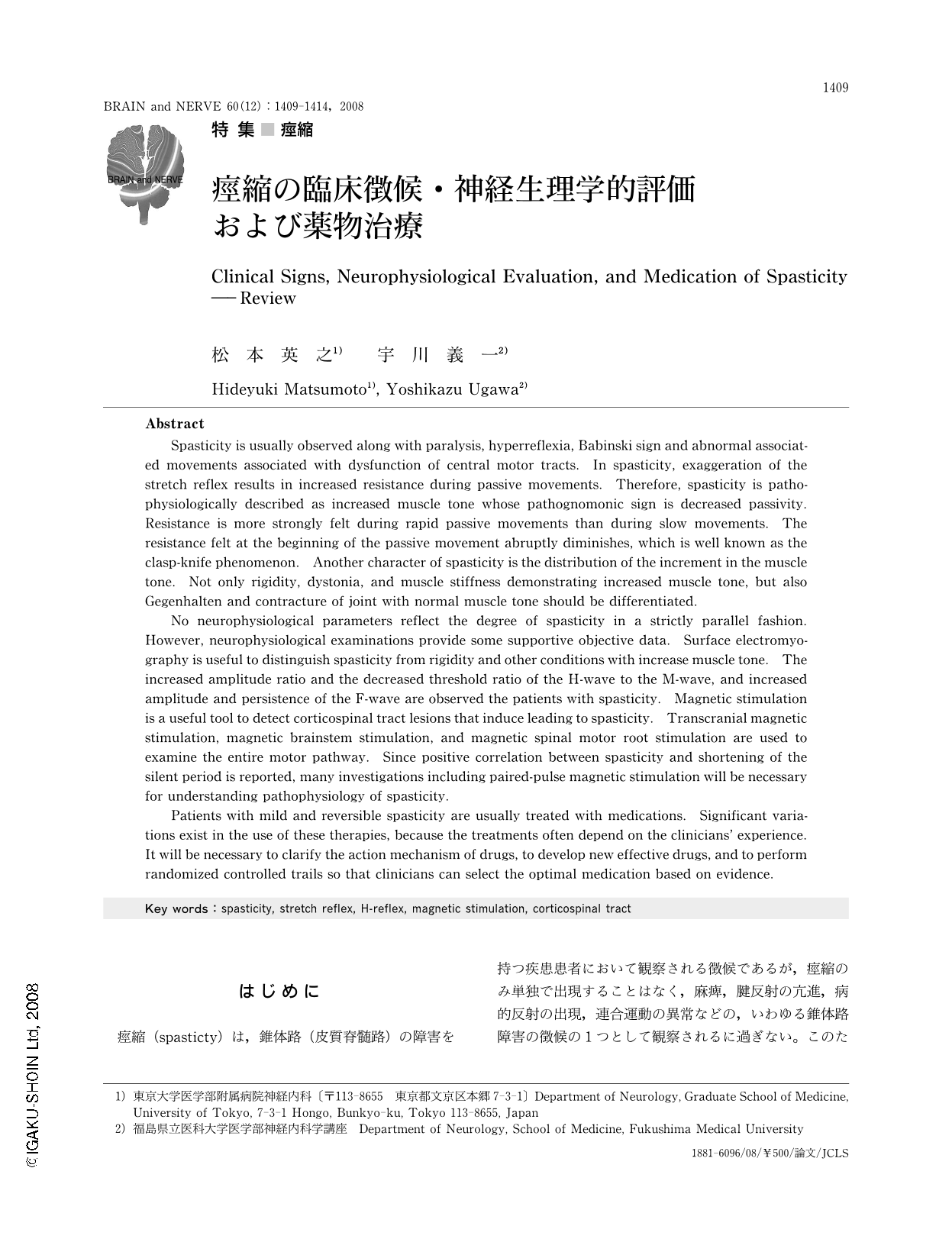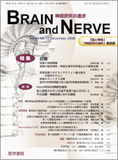Japanese
English
- 有料閲覧
- Abstract 文献概要
- 1ページ目 Look Inside
- 参考文献 Reference
はじめに
痙縮(spasticty)は,錐体路(皮質脊髄路)の障害を持つ疾患患者において観察される徴候であるが,痙縮のみ単独で出現することはなく,麻痺,腱反射の亢進,病的反射の出現,連合運動の異常などの,いわゆる錐体路障害の徴候の1つとして観察されるに過ぎない。このため痙縮のみを臨床的に取り扱うことは通常はないが,一方で,痙縮により歩行障害をきたす,関節の拘縮をきたすなどで日常生活活動(ADL)の低下を招いてしまうということはしばしば観察される。また接触だけで誘発される高度のクローヌスは,睡眠の妨げにもなる。このため病態を理解し,適切に診断・治療するということが必要となる。
痙縮は錐体路徴候の1つと一般的に考えられているが,厳密にはこれは正しくない。というのも,サルの大脳運動野(area 4 of Brodmann)を破壊した場合,対側の片麻痺とBabinski徴候がみられるが,長期間観察しても痙縮はみられず,弛緩性麻痺が持続し,腱反射も低下する。一方,運動前野(area 6)を破壊した場合,痙縮を伴う不全片麻痺となる1,2)。ヒトの場合,サルのようにはっきり区別されるわけではないが,やはりこれらの領域(area 4と6)が同時に破壊された場合,Babinski徴候を伴う痙性片麻痺を呈する3)。また大脳運動野のBetz細胞からの線維は,延髄錐体部では3%を占めるに過ぎない4)。現在のところ,錐体路というと臨床では大脳運動野のBetz細胞から脊髄前角細胞への線維を指す場合が多いが,錐体路を延髄錐体部を通る線維と定義すると皮質脊髄路はそのほんの一部に過ぎず,錐体路自体の概念を再考する必要があると考えられている。このような背景があるものの,本稿では理解しやすくするため,簡略化し,痙縮を錐体路障害によって生じる徴候として扱うこととする。
ここでは,臨床の場面で痙縮を診察するにあたり,必要不可欠と思われるポイントを重点的に記載したい。まずは痙縮の理解のために病態について簡単に触れ,次に診察・評価の際に重要となる痙縮の徴候と神経生理学的アプローチを中心に評価法について述べ,最後に薬物治療の現状を述べることとする。
Abstract
Spasticity is usually observed along with paralysis, hyperreflexia, Babinski sign and abnormal associated movements associated with dysfunction of central motor tracts. In spasticity, exaggeration of the stretch reflex results in increased resistance during passive movements. Therefore, spasticity is pathophysiologically described as increased muscle tone whose pathognomonic sign is decreased passivity. Resistance is more strongly felt during rapid passive movements than during slow movements. The resistance felt at the beginning of the passive movement abruptly diminishes, which is well known as the clasp-knife phenomenon. Another character of spasticity is the distribution of the increment in the muscle tone. Not only rigidity, dystonia, and muscle stiffness demonstrating increased muscle tone, but also Gegenhalten and contracture of joint with normal muscle tone should be differentiated.
No neurophysiological parameters reflect the degree of spasticity in a strictly parallel fashion. However, neurophysiological examinations provide some supportive objective data. Surface electromyography is useful to distinguish spasticity from rigidity and other conditions with increase muscle tone. The increased amplitude ratio and the decreased threshold ratio of the H-wave to the M-wave, and increased amplitude and persistence of the F-wave are observed the patients with spasticity. Magnetic stimulation is a useful tool to detect corticospinal tract lesions that induce leading to spasticity. Transcranial magnetic stimulation, magnetic brainstem stimulation, and magnetic spinal motor root stimulation are used to examine the entire motor pathway. Since positive correlation between spasticity and shortening of the silent period is reported, many investigations including paired-pulse magnetic stimulation will be necessary for understanding pathophysiology of spasticity.
Patients with mild and reversible spasticity are usually treated with medications. Significant variations exist in the use of these therapies,because the treatments often depend on the clinicians' experience. It will be necessary to clarify the action mechanism of drugs,to develop new effective drugs,and to perform randomized controlled trails so that clinicians can select the optimal medication based on evidence.

Copyright © 2008, Igaku-Shoin Ltd. All rights reserved.


